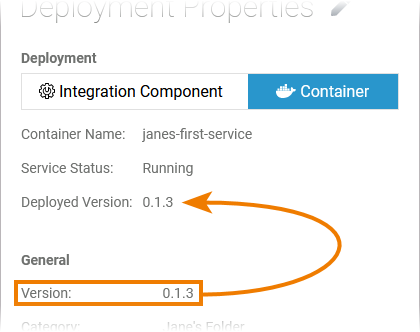- Created by Simon Wack, last modified by Annegret Bernhardt on Jan 04, 2024
We recommend using container deployment as the default deloyment target starting with PAS 23.1. For further information see:
Prerequisites
If you want to deploy a service as a container, your user must be assigned the xuml_container_admin profile. Refer to Administration Guide > Overview of Standard Profiles.
| The deployment properties for deployment target Container are displayed in section General. |
The following properties are displayed in read-only mode:
Option | Description | Possible Values |
|---|---|---|
Container Name | Shows the name of the container to which the service will be/was deployed. | The container name is generated from the service name according to the following rules:
Example:
Service Naming Given two services: ServiceName and servicename
|
| Service Status | Shows the current status of the service. |
|
| Deployed Version | Shows the number of the currently deployed version. | The version number is defined in section General: Expert Advice By default, each newly created service gets number 0.1.0 assigned. We recommend to increase the version number before redeploying each time you have made relevant changes to the service. You can change the version number in section General of the Deployment Properties. Follow the concept of semantic versioning. In case of deployment problems, comparing the version number and the number of the deployed version can help to find out which version of the service is running. |
The following service properties are displayed in the General section and can be changed:
| GENERAL | ||
|---|---|---|
| Deployment Property | Input Type | Description |
| Version | String | Insert a version number for your service. The version number is displayed in the container. The version of the service must follow Semantic Versioning 2.0.0: Major.Minor.Patch. A pre-release tag is optional. A version numbering that deviates from this will lead to errors during deployment. |
| Category | String | Category in which the service is displayed in the container. By default, the name of the folder where the service is stored is used. |
| Enable Validation | Boolean | Activate this option (Yes) to enable automatic compilation with each change in the respective model. Deactivate (No) the checkbox to disable the automatic compilation. If you chose this option, you can trigger the compilation manually via Start validation Default is Yes. |
| Enable Angular Build | Boolean | Activate this option (Yes) to enable the possibility to export your service as an Angular project for further pro-code development. You can find the export option in the additional menu of the controls panel. Default is Yes. Expert Advice If your process does not contain user tasks with assigned forms and if you do not need the instance table, we recommend to disable this option. The deployment will be much faster and the repository file much smaller. |
- No labels

